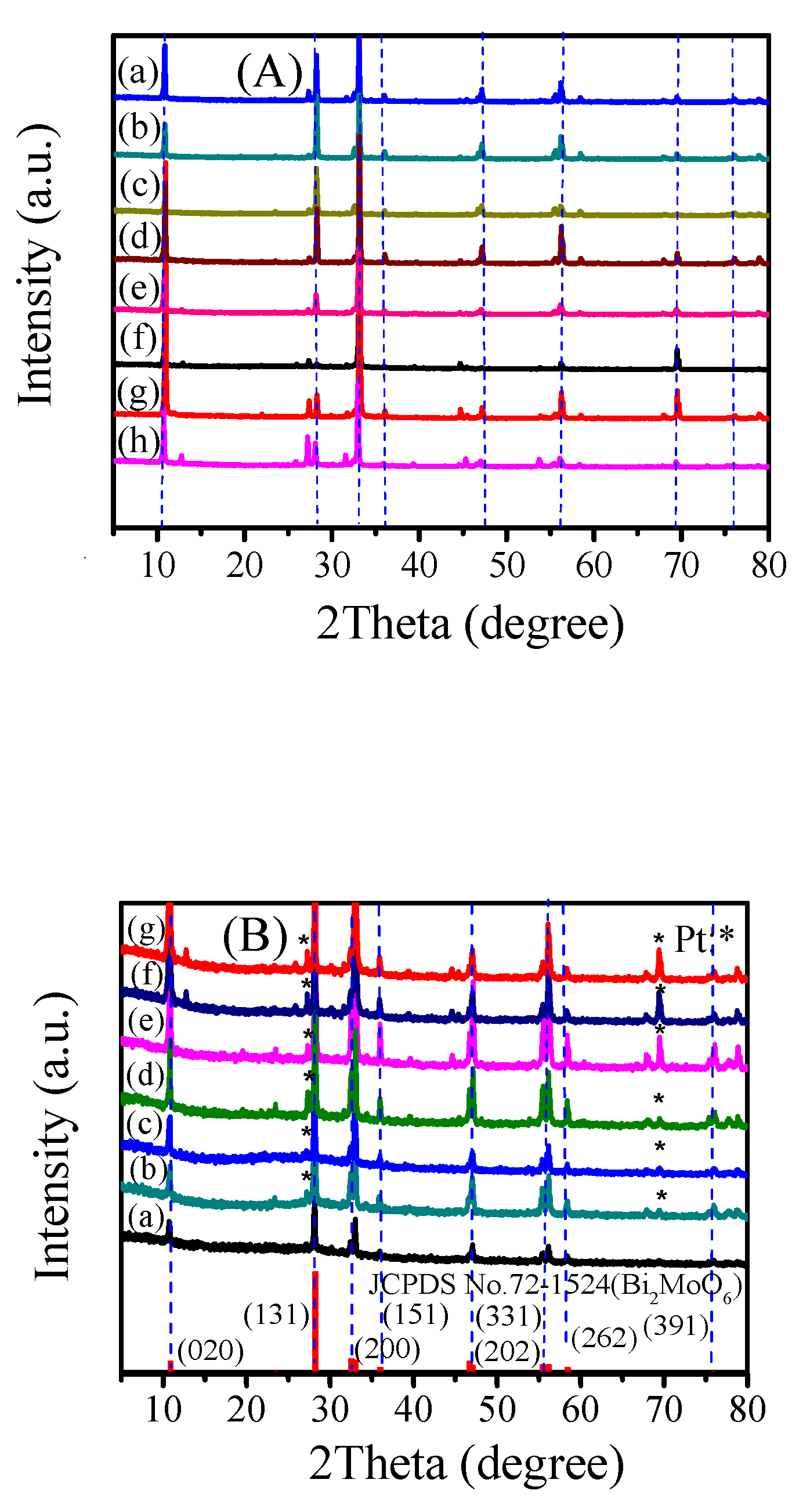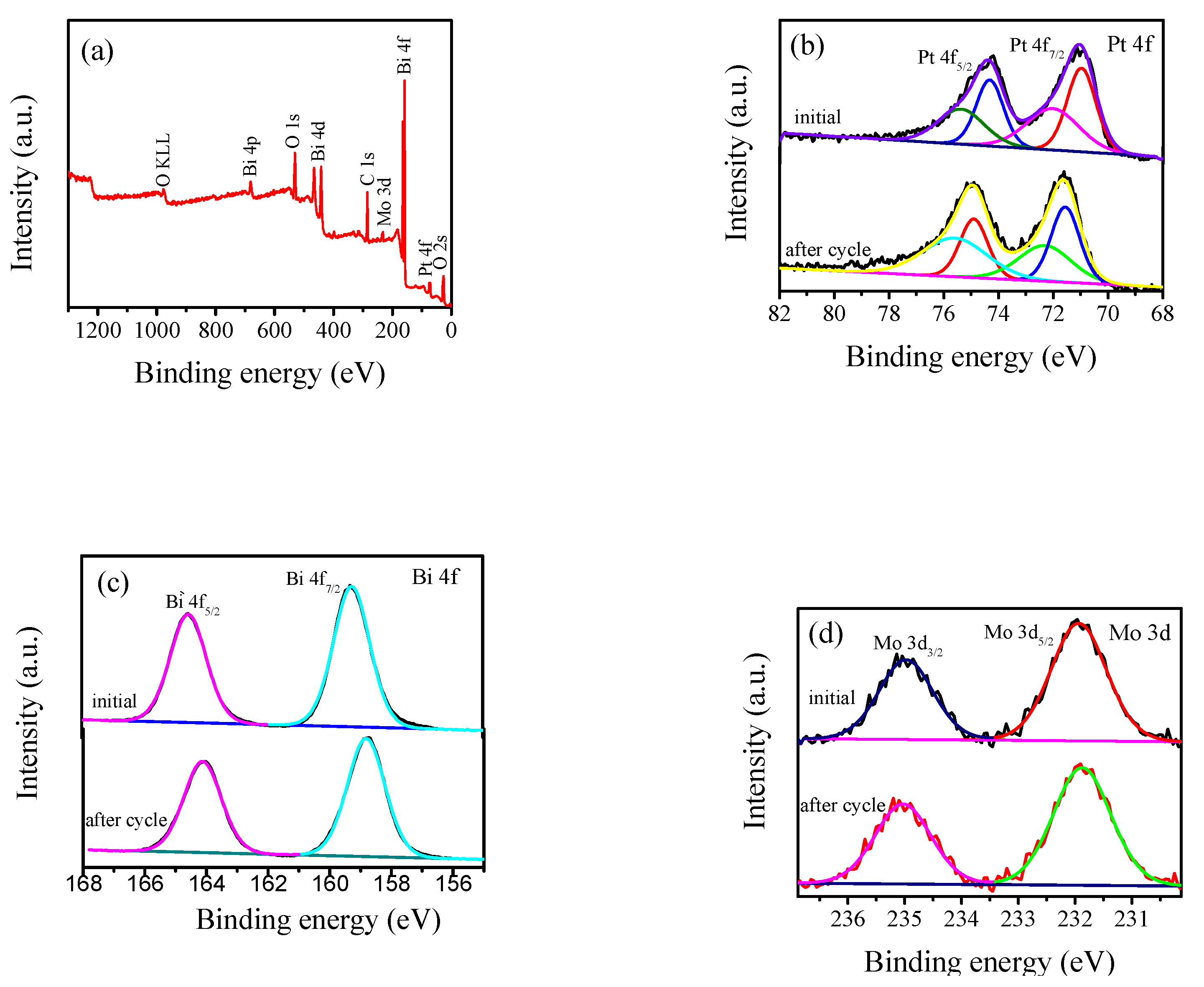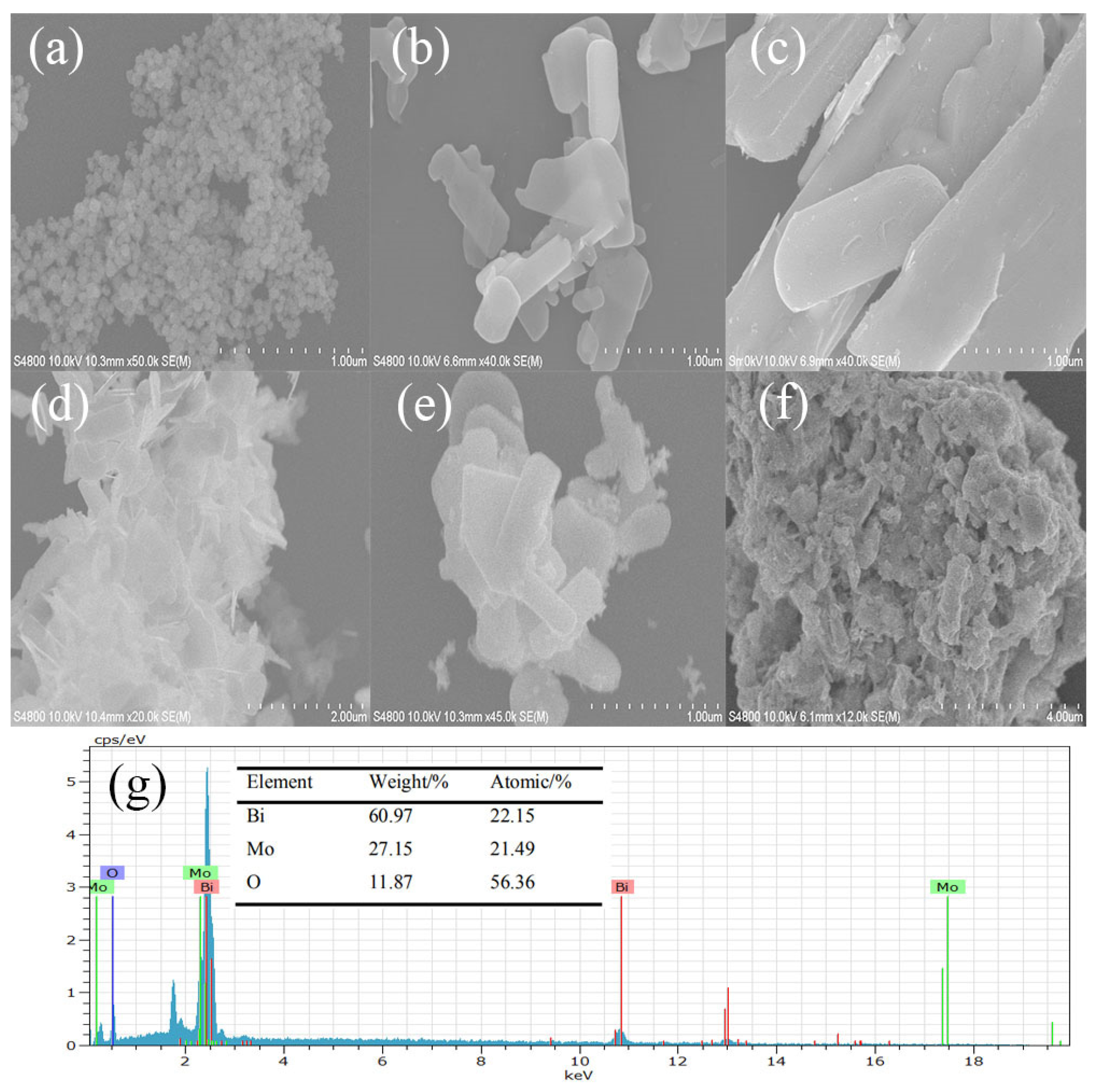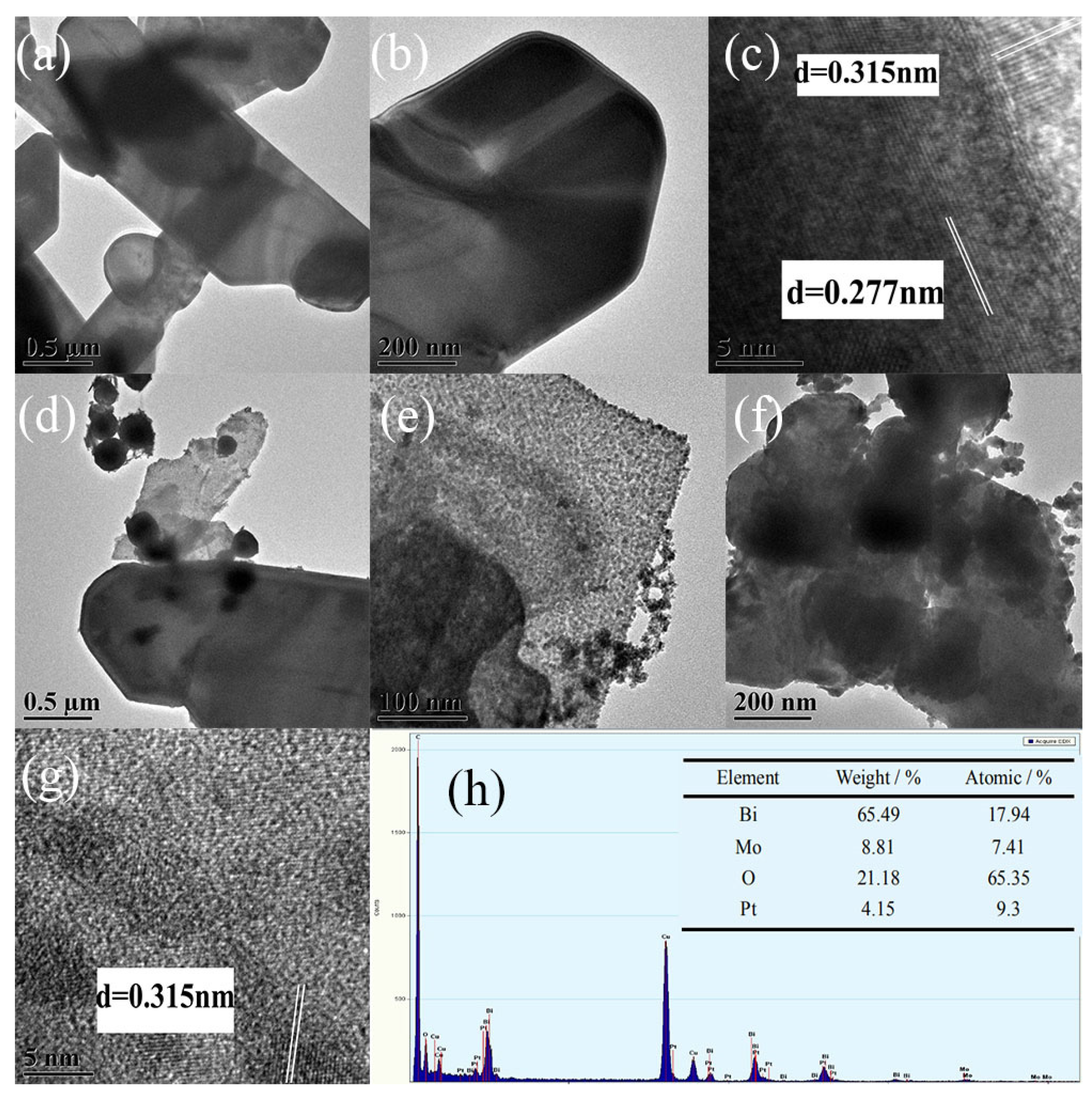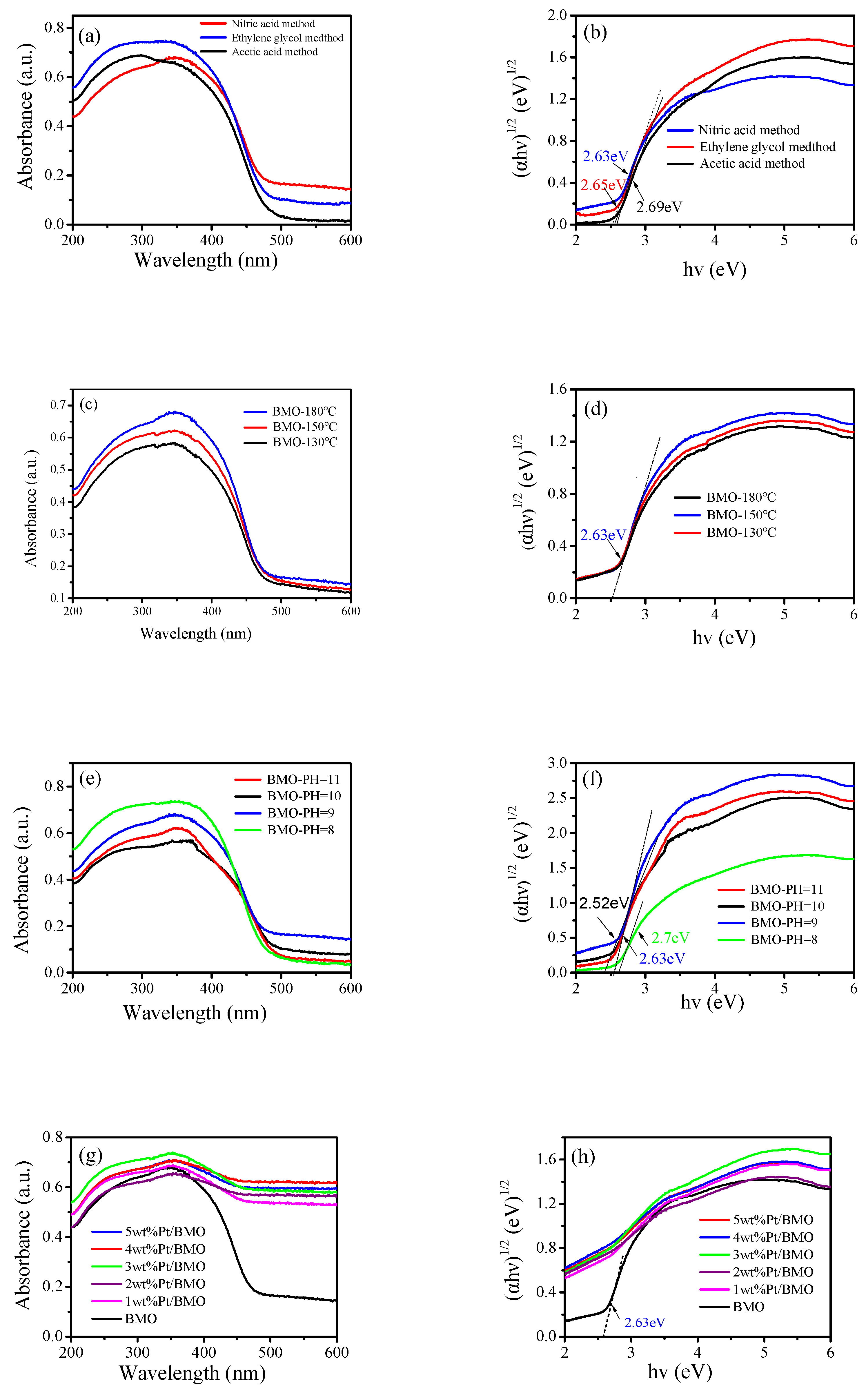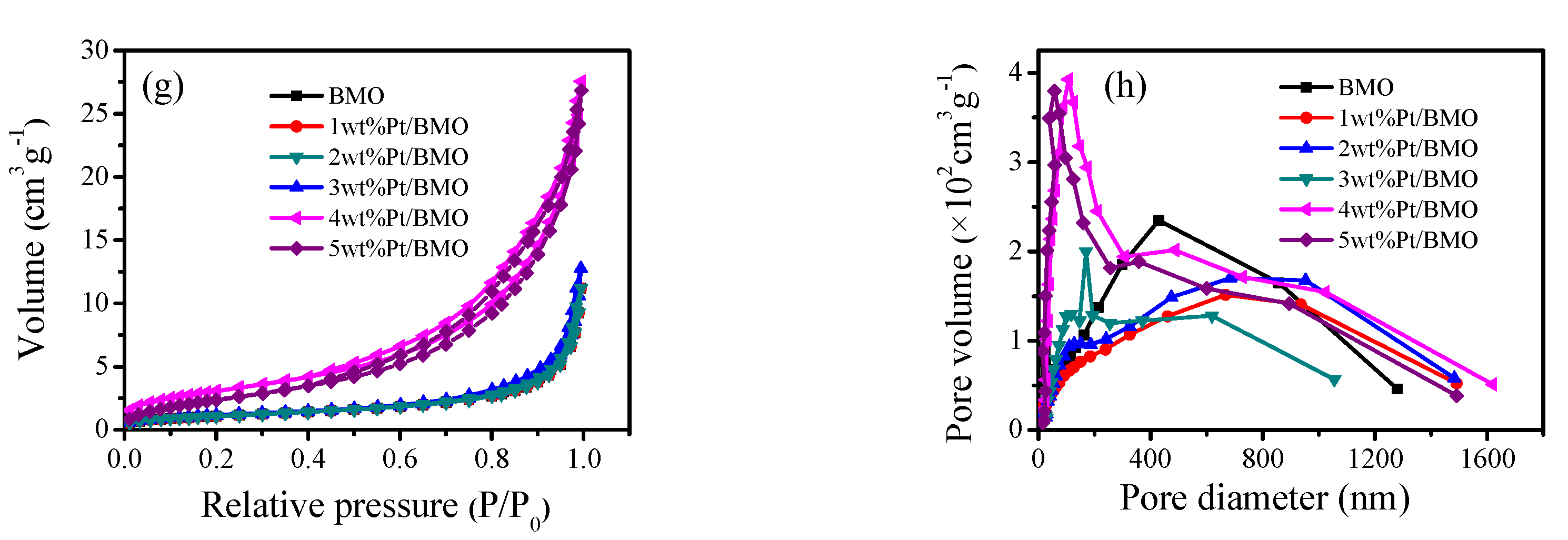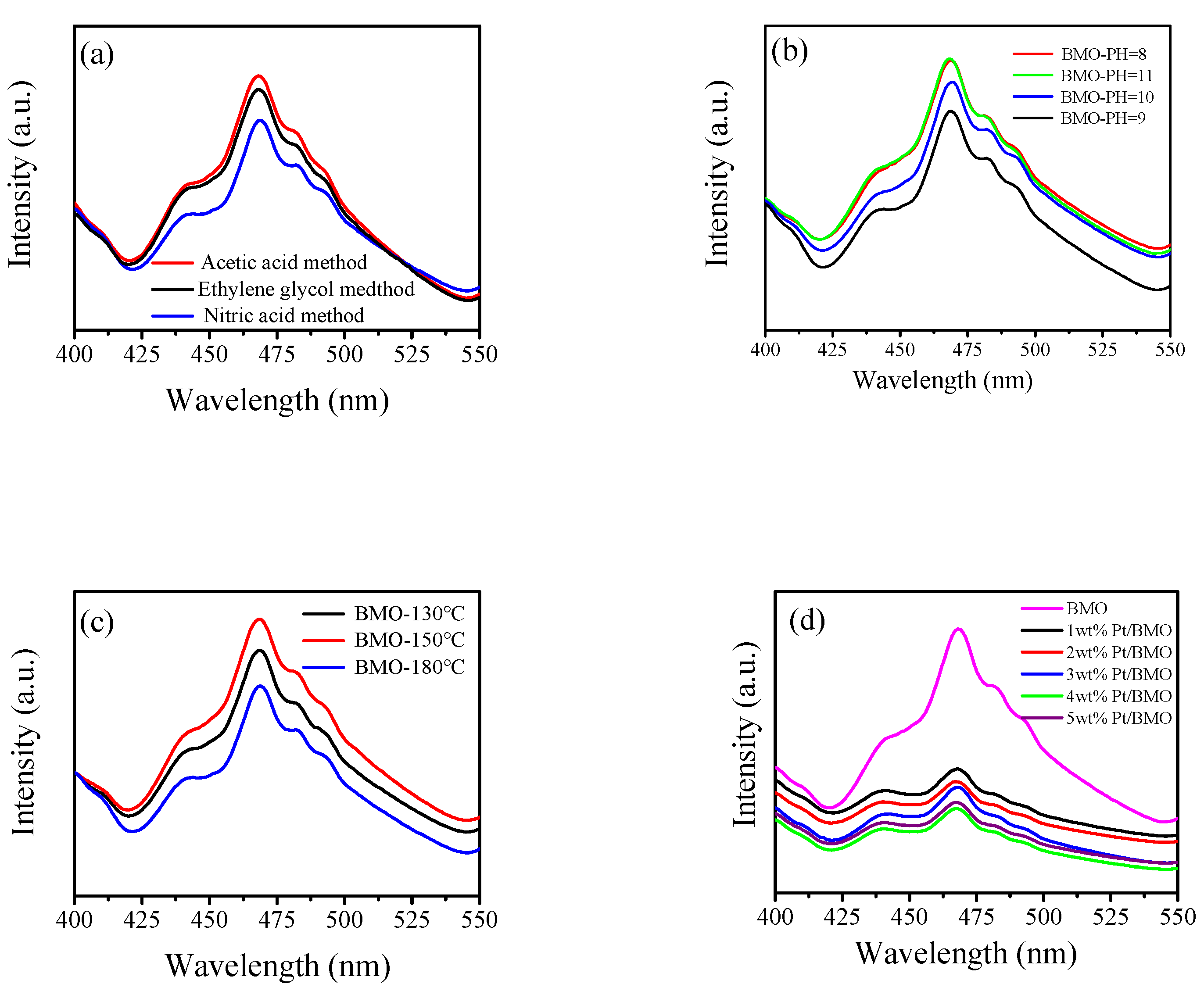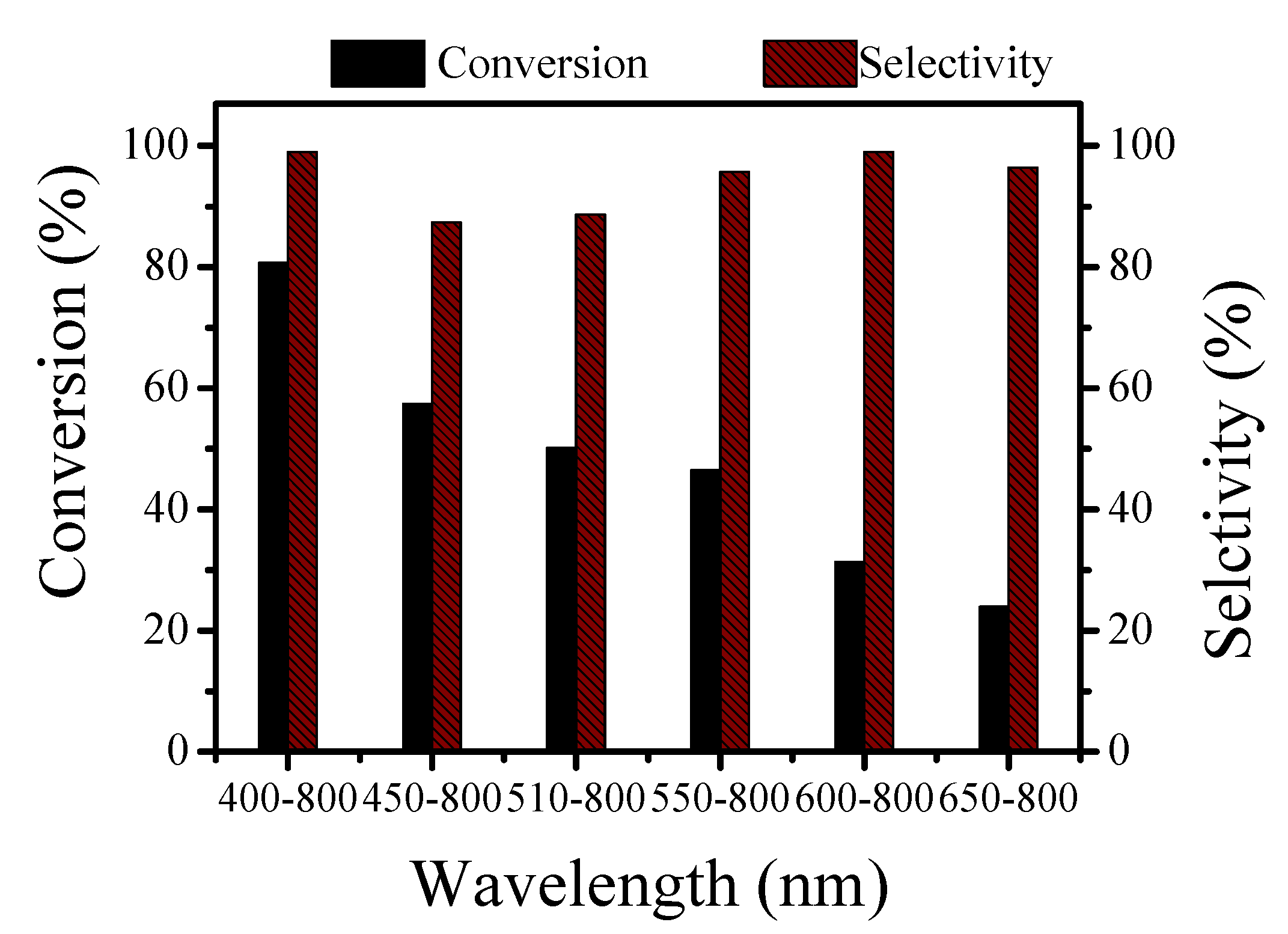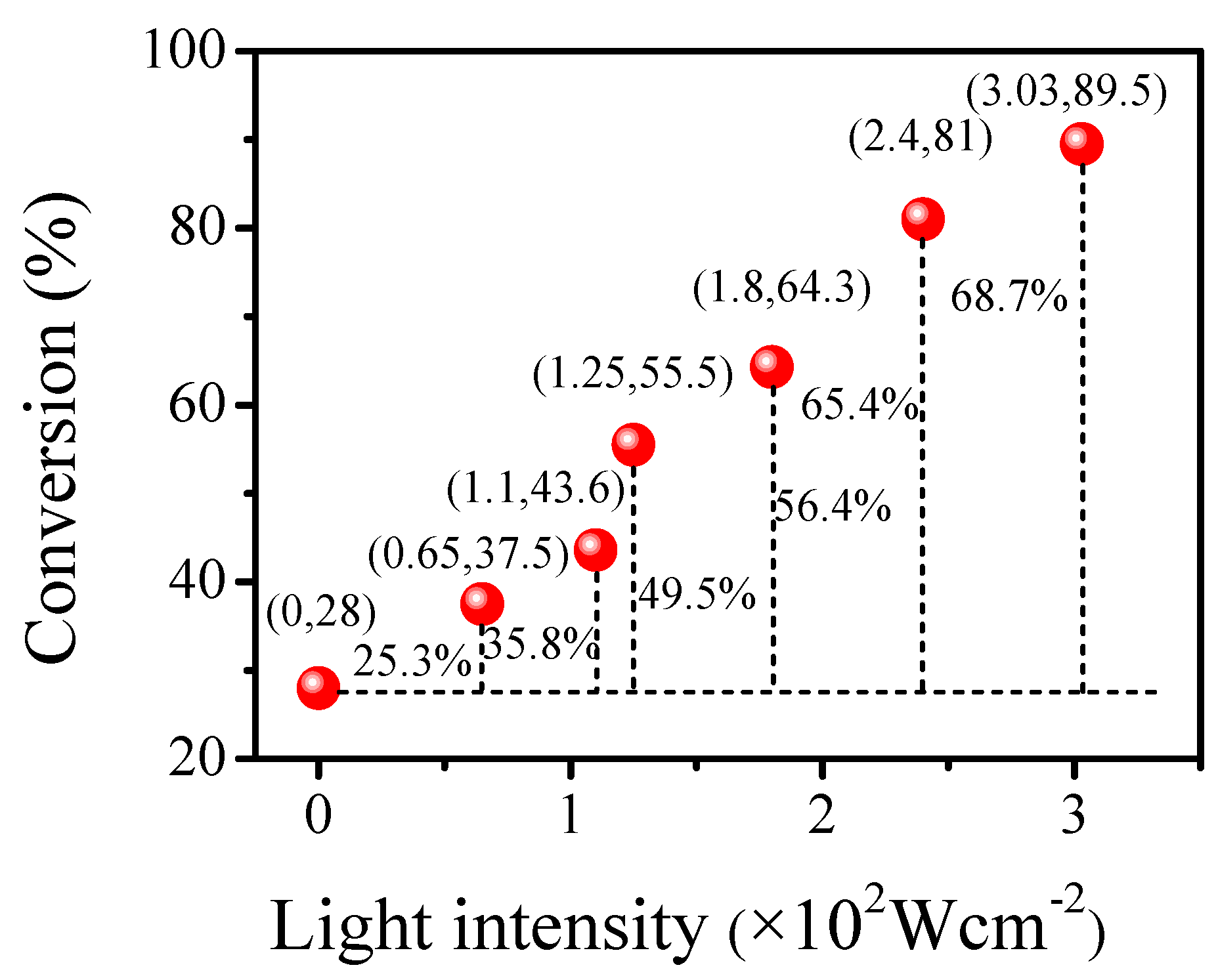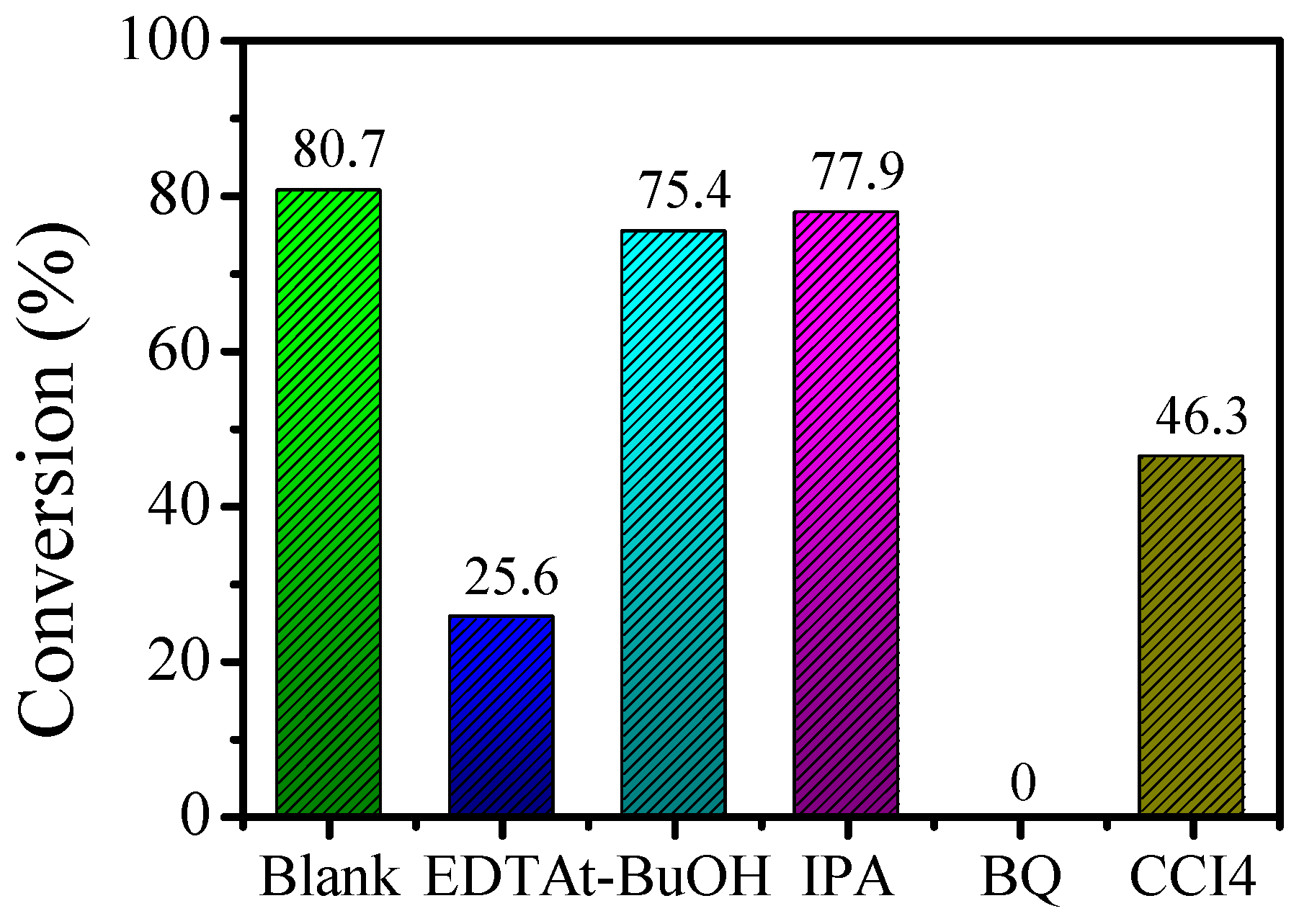Figure 1.
(A) XRD patterns of different catalysts: (a–c) γ-Bi2MoO6 (ethylene glycol method, nitric acid method, and glacial acetic method, pH = 9, 180 °C), (d–e) γ-Bi2MoO6 (nitric acid method, pH = 9, 150 °C, and 130 °C), (f–h) γ-Bi2MoO6 (nitric acid method, pH = 8, 10, and 11, 180 °C). (B) XRD patterns of different catalysts: (a) γ-Bi2MoO6 (nitric acid method, pH = 9, 180 °C), (b–f) 1 wt %, 2 wt %, 3 wt %, 4 wt %, and 5 wt % Pt/γ-Bi2Mo6 (nitric acid method, pH = 9, 180 °C), and (g) recycled 4 wt % Pt/γ-Bi2MoO6 (nitric acid method, pH = 9, 180 °C).
Figure 1.
(A) XRD patterns of different catalysts: (a–c) γ-Bi2MoO6 (ethylene glycol method, nitric acid method, and glacial acetic method, pH = 9, 180 °C), (d–e) γ-Bi2MoO6 (nitric acid method, pH = 9, 150 °C, and 130 °C), (f–h) γ-Bi2MoO6 (nitric acid method, pH = 8, 10, and 11, 180 °C). (B) XRD patterns of different catalysts: (a) γ-Bi2MoO6 (nitric acid method, pH = 9, 180 °C), (b–f) 1 wt %, 2 wt %, 3 wt %, 4 wt %, and 5 wt % Pt/γ-Bi2Mo6 (nitric acid method, pH = 9, 180 °C), and (g) recycled 4 wt % Pt/γ-Bi2MoO6 (nitric acid method, pH = 9, 180 °C).
Figure 2.
XPS spectra of 4 wt % Pt/Bi2MoO6 (nitric acid method, pH = 9, 180 °C) before and after cycling: (a) full spectrum, (b) Pt 4f, (c) Bi 4f, (d) Mo 3d, and (e) O 1s.
Figure 2.
XPS spectra of 4 wt % Pt/Bi2MoO6 (nitric acid method, pH = 9, 180 °C) before and after cycling: (a) full spectrum, (b) Pt 4f, (c) Bi 4f, (d) Mo 3d, and (e) O 1s.
Figure 3.
SEM images of the as-prepared samples: (a–d) γ-Bi2MoO6 (pH = 8, 9, 10, and 11, nitric acid method, 180 °C), (e) 4 wt % Pt/γ-Bi2MoO6 (nitric acid method, pH = 9, 180 °C), (f) recycled 4 wt % Pt/γ-Bi2MoO6 (nitric acid method, pH = 9, 180 °C), and (g) the corresponding EDX spectra of γ-Bi2MoO6 (nitric acid method, pH = 9, 180 °C).
Figure 3.
SEM images of the as-prepared samples: (a–d) γ-Bi2MoO6 (pH = 8, 9, 10, and 11, nitric acid method, 180 °C), (e) 4 wt % Pt/γ-Bi2MoO6 (nitric acid method, pH = 9, 180 °C), (f) recycled 4 wt % Pt/γ-Bi2MoO6 (nitric acid method, pH = 9, 180 °C), and (g) the corresponding EDX spectra of γ-Bi2MoO6 (nitric acid method, pH = 9, 180 °C).
Figure 4.
TEM images of the as-prepared samples: (a–c) γ-Bi2MoO6 (nitric acid method, pH = 9, 180 °C), (d–e) 4 wt % Pt/γ-Bi2MoO6 (nitric acid method, pH = 9, 180 °C), (f–g) recycled 4 wt % Pt/γ-Bi2MoO6 (nitric acid method, pH = 9, 180 °C), and (h) the corresponding EDX spectra of 4 wt % Pt/γ-Bi2MoO6 (nitric acid method, pH = 9, 180 °C).
Figure 4.
TEM images of the as-prepared samples: (a–c) γ-Bi2MoO6 (nitric acid method, pH = 9, 180 °C), (d–e) 4 wt % Pt/γ-Bi2MoO6 (nitric acid method, pH = 9, 180 °C), (f–g) recycled 4 wt % Pt/γ-Bi2MoO6 (nitric acid method, pH = 9, 180 °C), and (h) the corresponding EDX spectra of 4 wt % Pt/γ-Bi2MoO6 (nitric acid method, pH = 9, 180 °C).
Figure 5.
UV-vis diffuse reflectance spectroscopy (DRS) patterns of γ-Bi2MoO6 with: (a,b) different preparation methods, (c,d) different hydrothermal temperatures, and (e,f) different pH values and UV-vis DRS patterns of Pt/γ-Bi2MoO6 with (g,h) different mass fractions of Pt.
Figure 5.
UV-vis diffuse reflectance spectroscopy (DRS) patterns of γ-Bi2MoO6 with: (a,b) different preparation methods, (c,d) different hydrothermal temperatures, and (e,f) different pH values and UV-vis DRS patterns of Pt/γ-Bi2MoO6 with (g,h) different mass fractions of Pt.
Figure 6.
N2 adsorption–desorption isotherm curve (Brunauer-Emmett-Teller, BET) of γ-Bi2MoO6 with: (a,b) different preparation methods, (c,d) different hydrothermal temperatures, and (e,f) different pH values and N2 adsorption–desorption isotherm curve (BET) of Pt/γ-Bi2MoO6 with (g,h) different mass fraction of Pt.
Figure 6.
N2 adsorption–desorption isotherm curve (Brunauer-Emmett-Teller, BET) of γ-Bi2MoO6 with: (a,b) different preparation methods, (c,d) different hydrothermal temperatures, and (e,f) different pH values and N2 adsorption–desorption isotherm curve (BET) of Pt/γ-Bi2MoO6 with (g,h) different mass fraction of Pt.
Figure 7.
Photoluminescence spectra of γ-Bi2MoO6 with: (a) different preparation methods, (b) different pH values, and (c) different hydrothermal temperatures. Photoluminescence spectra of Pt/γ-Bi2MoO6 with (d) different mass fractions of Pt.
Figure 7.
Photoluminescence spectra of γ-Bi2MoO6 with: (a) different preparation methods, (b) different pH values, and (c) different hydrothermal temperatures. Photoluminescence spectra of Pt/γ-Bi2MoO6 with (d) different mass fractions of Pt.
Figure 8.
Effect of different light wavelengths on the reaction of benzyl alcohol and acetophenone.
Figure 8.
Effect of different light wavelengths on the reaction of benzyl alcohol and acetophenone.
Figure 9.
Effect of different light intensities on the reaction of benzyl alcohol and acetophenone.
Figure 9.
Effect of different light intensities on the reaction of benzyl alcohol and acetophenone.
Figure 10.
The recycling ability test of 4 wt % Pt/γ-Bi2MoO6 on the reaction of benzyl alcohol and acetophenone.
Figure 10.
The recycling ability test of 4 wt % Pt/γ-Bi2MoO6 on the reaction of benzyl alcohol and acetophenone.
Figure 11.
Effects of scavengers on the reaction of benzyl alcohol and acetophenone.
Figure 11.
Effects of scavengers on the reaction of benzyl alcohol and acetophenone.
Table 1.
Specific surface areas of the different catalysts.
Table 1.
Specific surface areas of the different catalysts.
| Variate | Sample BET | Surface Area (m2·g−1) |
|---|
| | Nitric acid | 3.26 |
| Preparation method | Ethylene glycol | 2.71 |
| | Acetic acid | 13.08 |
| | pH = 8 | 3.15 |
| pH value | pH = 9 | 3.26 |
| (Nitric acid method) | pH = 10 | 4.39 |
| | pH = 11 | 6.28 |
| Hydrothermal temperature (Nitric acid method) | 130 °C | 2.65 |
| 150 °C | 3.08 |
| 180 °C | 3.26 |
| Different mass fraction | 1 wt % Pt | 5.27 |
| 2 wt % Pt | 7.85 |
| 3 wt % Pt | 13.45 |
| 4 wt % Pt | 19.63 |
| | 5 wt % Pt | 17.35 |
Table 2.
Effect of the different catalysts on the reaction of benzyl alcohol and acetophenone.
Table 2.
Effect of the different catalysts on the reaction of benzyl alcohol and acetophenone.
| No. | Catalyst | Under Visible Light | In the Dark |
|---|
| Conv. (%) | Sel. (%) | Conv. (%) | Sel. (%) |
|---|
| 1 | BMO (N, pH = 9, 180 °C) | 37.6 | >99 | 1.1 | >99 |
| 2 | BMO (E, pH = 9, 180 °C) | 15.2 | >99 | 0.5 | >99 |
| 3 | BMO (A, pH = 9, 180 °C) | 5.7 | >99 | 0.1 | >99 |
| 4 | BMO (pH = 8, N, 180 °C) | 24.3 | >99 | 0.5 | >99 |
| 5 | BMO (pH = 10, N, 180 °C) | 35.5 | >99 | 0.8 | >99 |
| 6 | BMO (pH = 11, N, 180 °C) | 29.4 | >99 | 0.6 | >99 |
| 7 | BMO (150 °C, N, pH = 9) | 32.1 | >99 | 0.9 | >99 |
| 8 | BMO (130 °C, N, pH = 9) | 27.2 | >99 | 0.8 | >99 |
| 9 | 1 wt % Pt/BMO (N) | 44.8 | >99 | 1.7 | >99 |
| 10 | 2 wt % Pt/BMO (N) | 49.4 | >99 | 2.2 | >99 |
| 11 | 3 wt % Pt/BMO (N) | 50.7 | >99 | 3.5 | >99 |
| 12 | 4 wt % Pt/BMO (N) | 55.9 | >99 | 5.2 | >99 |
| 13 | 5 wt % Pt/BMO (N) | 43.3 | >99 | 1.9 | >99 |
Table 3.
Effect of different amounts of catalyst on the reaction of benzyl alcohol and acetophenone.
Table 3.
Effect of different amounts of catalyst on the reaction of benzyl alcohol and acetophenone.
| No. | Catalyst Amount (mg) | Under Visible Light | In the Dark |
|---|
| Conv. (%) | Sel. (%) | Conv. (%) | Sel. (%) |
|---|
| 1 | 0 | 0.9 | >99 | 0 | 0 |
| 2 | 25 | 27.2 | >99 | 1.4 | >99 |
| 3 | 50 | 55.9 | >99 | 5.2 | >99 |
| 4 | 75 | 65.3 | >99 | 7.8 | >99 |
| 5 | 100 | 57.5 | >99 | 5.4 | >99 |
Table 4.
Effect of different solvents on the reaction of benzyl alcohol and acetophenone.
Table 4.
Effect of different solvents on the reaction of benzyl alcohol and acetophenone.
| No. | Solvent | Polar Index | Under Visible Light | In the Dark |
|---|
| Conv. (%) | Sel. (%) | Conv. (%) | Sel. (%) |
|---|
| 1 | DMSO | 7.2 | 0.5 | >99 | 0 | 0 |
| 3 | DMF | 6.4 | 7.2 | >99 | 0 | 0 |
| 4 | Acetonitrile | 6.2 | 11.2 | >99 | 0.3 | >99 |
| 5 | 1,4-Dioxane | 4.8 | 45.3 | >99 | 1.7 | >99 |
| 6 | Isopropanol | 4.3 | 49.1 | >99 | 4.5 | >99 |
| 7 | Tetrahydrofura | 4.2 | 20.1 | >99 | 0.9 | 71.8 |
| 8 | Mesitylene | 1.9 | 5.7 | >99 | 0 | 0 |
| 9 | Cyclohexane | 0.1 | 7.3 | >99 | 0 | 0 |
| 10 | n-Heptane | 0.06 | 65.3 | >99 | 7.8 | >99 |
| 11 | Petroleum ether | 0.01 | 17.5 | >99 | 0.4 | >99 |
| 12 | n-Hexane | 0 | 36.2 | >99 | 3.8 | >99 |
Table 5.
Effect of the different bases on the reaction of benzyl alcohol and acetophenone.
Table 5.
Effect of the different bases on the reaction of benzyl alcohol and acetophenone.
| No. | Base | Under Visible Light | In the Dark |
|---|
| Conv. (%) | Sel. (%) | Conv. (%) | Sel. (%) |
|---|
| 1 | NaOH | 65.3 | >99 | 7.8 | >99 |
| 2 | KOH | 27.2 | 94.5 | 0.5 | 36.2 |
| 3 | LiOH | 30.7 | 91.2 | 4.1 | 67.3 |
| 4 | Na2CO3 | 5.7 | 87.3 | 0 | 0 |
| 5 | K2CO3 | 3.8 | 97.9 | 0.4 | 21.7 |
| 6 | CH3ONa | 25.1 | >99 | 0.6 | >99 |
| 7 | Cs2CO3 | 19.3 | >99 | 0.3 | 40.1 |
| 8 | Blank | 0.5 | 94.3 | 0 | 0 |
Table 6.
Effect of different amounts of base on the reaction of benzyl alcohol and acetophenone.
Table 6.
Effect of different amounts of base on the reaction of benzyl alcohol and acetophenone.
| No. | Base Amount (mmol) | Under Visible Light | In the Dark |
|---|
| Conv. (%) | Sel. (%) | Conv. (%) | Sel. (%) |
|---|
| 1 | 0 | 1.3 | >99 | 0 | 0 |
| 2 | 0.6 | 14.3 | >99 | 1.5 | >99 |
| 3 | 0.8 | 26.7 | >99 | 1.4 | >99 |
| 4 | 1.0 | 65.3 | >99 | 7.8 | >99 |
| 5 | 1.2 | 71.7 | >99 | 8.2 | >99 |
| 6 | 1.4 | 57.5 | >99 | 5.4 | >99 |
Table 7.
Effect of different amounts of reactants on the reaction of benzyl alcohol and acetophenone.
Table 7.
Effect of different amounts of reactants on the reaction of benzyl alcohol and acetophenone.
| No. | Benzyl Alcohol
(mmol) | Benzyl Acetophenone (mmol) | Under Visible Light | In the Dark |
|---|
| Conv. (%) | Sel. (%) | Conv. (%) | Sel. (%) |
|---|
| 1 | 1.0 | 1.0 | 71.7 | >99 | 8.2 | >99 |
| 2 | 2.0 | 1.0 | 76.5 | >99 | 8.7 | >99 |
| 3 | 3.0 | 1.0 | 80.7 | >99 | 9.3 | >99 |
| 4 | 4.0 | 1.0 | 74.7 | >99 | 7.9 | >99 |
| 5 | 3.0 | 2.0 | 36.5 | >99 | 4.9 | >99 |
| 6 | 3.0 | 3.0 | 21.9 | >99 | 3.2 | >99 |
Table 8.
Effect of the different alcohol and acetophenone derivatives on the reaction of benzyl alcohol and acetophenone.

